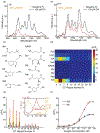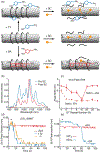Ultralarge Modulation of Fluorescence by Neuromodulators in Carbon Nanotubes Functionalized with Self-Assembled Oligonucleotide Rings
- PMID: 30350638
- PMCID: PMC6771428
- DOI: 10.1021/acs.nanolett.8b02937
Ultralarge Modulation of Fluorescence by Neuromodulators in Carbon Nanotubes Functionalized with Self-Assembled Oligonucleotide Rings
Abstract
Noncovalent interactions between single-stranded DNA (ssDNA) oligonucleotides and single wall carbon nanotubes (SWNTs) have provided a unique class of tunable chemistries for a variety of applications. However, mechanistic insight into both the photophysical and intermolecular phenomena underlying their utility is lacking, which results in obligate heuristic approaches for producing ssDNA-SWNT based technologies. In this work, we present an ultrasensitive "turn-on" nanosensor for neuromodulators dopamine and norepinephrine with strong relative change in fluorescence intensity (Δ F/ F0) of up to 3500%, a signal appropriate for in vivo neuroimaging, and uncover the photophysical principles and intermolecular interactions that govern the molecular recognition and fluorescence modulation of this nanosensor synthesized from the spontaneous self-assembly of (GT)6 ssDNA rings on SWNTs. The fluorescence modulation of the ssDNA-SWNT conjugate is shown to exhibit remarkable sensitivity to the ssDNA sequence chemistry, length, and surface density, providing a set of parameters with which to tune nanosensor dynamic range, analyte selectivity and strength of fluorescence turn-on. We employ classical and quantum mechanical molecular dynamics simulations to rationalize our experimental findings. Calculations show that (GT)6 ssDNA form ordered rings around (9,4) SWNTs, inducing periodic surface potentials that modulate exciton recombination lifetimes. Further evidence is presented to elucidate how dopamine analyte binding modulates SWNT fluorescence. We discuss the implications of our findings for SWNT-based molecular imaging applications.
Keywords: Single wall carbon nanotubes; molecular dynamics simulations; molecular sensing; neuromodulation.
Conflict of interest statement
The authors declare no competing financial interests.
Figures



References
-
- McEuen PL, Fuhrer MS & Park H Single-walled carbon nanotube electronics. Nanotechnology, IEEE Trans. (2002). doi:10.1109/TNANO.2002.1005429 - DOI
-
- He X et al. Tunable room-Temperature single-photon emission at telecom wavelengths from sp 3 defects in carbon nanotubes. Nat. Photonics (2017). doi:10.1038/nphoton.2017.119 - DOI
Publication types
MeSH terms
Substances
Grants and funding
LinkOut - more resources
Full Text Sources
Miscellaneous

